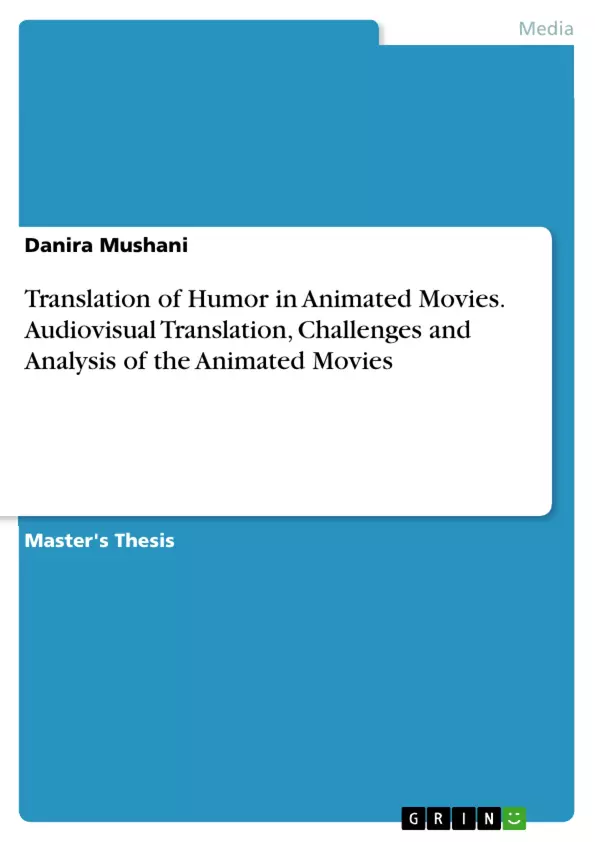The present thesis involves a theoretical and practical examination of the translation of humor. The study provides a knowledge base that includes diverse types of humor and jokes, cultural reference translation approaches, and a brief introduction to dubbing. This theoretical component is represented in the analysis of selected animated movies, in which some fragments from the original version are contrasted to portions that have previously been translated and dubbed into Albanian. This research demonstrates the many approaches used by the translator during the procedure as well as the potential issues that may arise. This project demonstrates that language and cultural mixing between two countries is difficult.
Inhaltsverzeichnis (Table of Contents)
- Objectives, Reasons for working on this topic
- Research Questions
- Problem statement
- Purpose of the study
- Humor
- Different Definitions of Humor
- Linguistic Theories of Humor
- Salvatore Attardo's Theories of Humor Translation
- Jeroen Vandaele's Humor in Translation
- Eugene Nida's Formal and Dynamic Equivalence
- Humor in animated movies
- Translation for Children
- Audiovisual Translation
- Types of Audiovisual Translation
- Challenges in Translating Humor
- Cultural References
- Verbal and Referential Humor
- Verbal Humor
- Puns and Allusions
- Graphic Elements
- Shrek Background
- Humour Translation Problems
- Madagascar Background
- Humour Translation Problems
- Megamind Background
- Humour Translation Problems
Zielsetzung und Themenschwerpunkte (Objectives and Key Themes)
This thesis aims to provide a comprehensive examination of the translation of humor in animated movies, specifically focusing on the challenges posed by cultural references and the adaptation of verbal humor for a different linguistic and cultural context. The study utilizes a theoretical framework incorporating different definitions of humor, linguistic theories of humor translation, and a brief overview of dubbing. This framework is then applied to the analysis of selected animated movies, contrasting original and translated versions to highlight the approaches and issues involved in translating humor for an Albanian audience.- Translation of humor in animated movies
- Challenges of cultural references in translation
- Adaptation of verbal humor for different cultural contexts
- Application of theoretical frameworks to practical translation analysis
- Comparison of original and translated versions of animated movies
Zusammenfassung der Kapitel (Chapter Summaries)
- Chapter 1: This chapter provides a comprehensive overview of humor, exploring various definitions and theories. It examines key linguistic theories of humor translation, including the contributions of Salvatore Attardo, Jeroen Vandaele, and Eugene Nida. This chapter lays the theoretical foundation for understanding the complexities of translating humor.
- Chapter 2: This chapter delves into the specific challenges of translating humor in animated movies, considering the unique context of translating for children. It explores different types of audiovisual translation and highlights the difficulties posed by cultural references, verbal and referential humor, and graphic elements.
- Chapter 3: This chapter presents an analysis of specific animated movies, including "Shrek", "Madagascar", and "Megamind". It examines the translation of humor in these movies, highlighting the challenges encountered and the strategies employed by translators. This practical analysis provides a concrete example of the theoretical concepts discussed in previous chapters.
Schlüsselwörter (Keywords)
The core concepts explored in this thesis revolve around the translation of humor, specifically in the context of animated movies. The study analyzes various types of humor, including verbal, visual, and situational humor, and examines how cultural references and linguistic nuances impact the translation process. Key terms like "cultural equivalence," "humor translation strategies," and "dubbing" are central to the investigation, along with the specific examples of "Shrek," "Madagascar," and "Megamind."- Citar trabajo
- Danira Mushani (Autor), 2022, Translation of Humor in Animated Movies. Audiovisual Translation, Challenges and Analysis of the Animated Movies, Múnich, GRIN Verlag, https://www.grin.com/document/1361233



